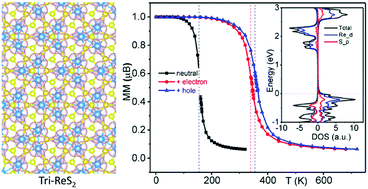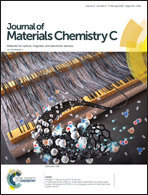A new phase of the two-dimensional ReS2 sheet with tunable magnetism†
Abstract
The two-dimensional (2D) rhenium disulfide crystal is well known to have an in-plane motif of parallel diamond-shaped chains (DT phase), leading to its significant anisotropy in terms of electrical and optical properties, and great potential applications in field-effect transistors, digital converters and photodetectors. On the basis of first-principles calculations, here, we report a new distorted phase of the 2D ReS2 sheet with tunable magnetic properties. Distinctly different from the well-known diamond-shaped chain structure in the DT phase, Re atoms form a uniform-distributed trimer in the distorted phase (Tri phase). The transition from the DT to the Tri phase can be induced with either electron doping or lithium atom intercalating. Both phonon spectrum calculations and Born–Oppenheimer molecular dynamic simulation at room temperature confirm the high structural stability of the Tri-phase ReS2 sheet. In particular, the Tri-phase ReS2 sheet is a bipolar magnetic semiconductor with a bandgap of 1.63 eV by using the hybrid HSE06 method, which can be further turned into half metals with ambipolar spin polarization via carrier doping. The estimated Curie temperature of the ReS2 sheet with the Tri phase is about 157 K, which can be further enhanced to 357 K via carrier doping. Much more interesting, it also has a huge magnetic anisotropy energy of 5.716 meV per Re atom due to the direct ferromagnetic coupling between Re atoms. The novel magnetic properties of the distorted phase of the ReS2 sheet present a potential applicability in nanoscale spintronics with the electrical-manipulation of spin-polarization orientation.



 Please wait while we load your content...
Please wait while we load your content...